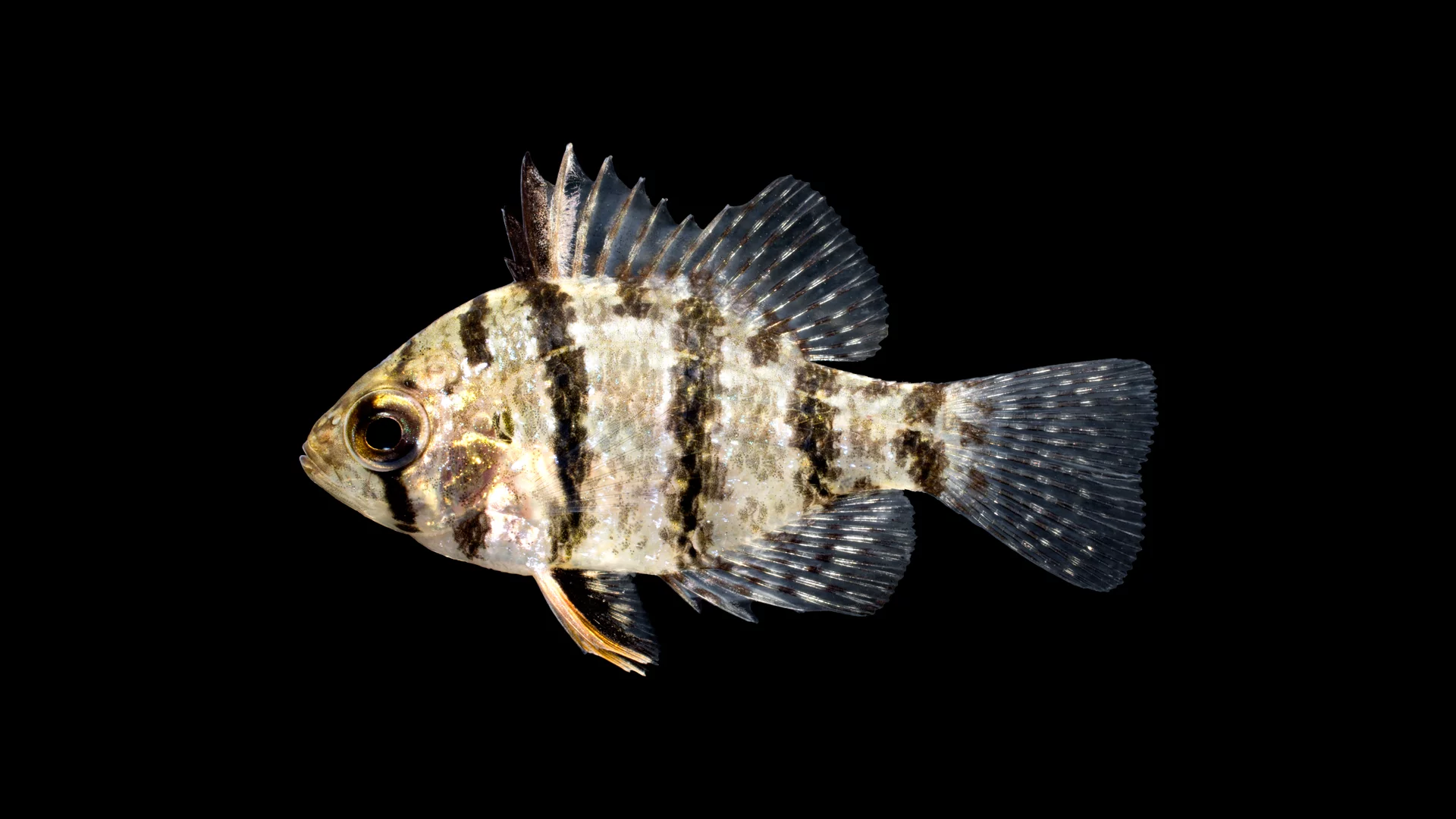You’ll be amazed by the fascinating world of the Blackbanded Sunfish. Found in freshwater habitats across North America, this small but mighty fish boasts striking black bands that adorn its vibrant body.
It feeds on insects, crustaceans, and other small aquatic organisms, using its sharp teeth and agile swimming skills to secure its meals. The Blackbanded Sunfish plays a crucial role in the aquatic ecosystem, serving as both predator and prey.
Get ready to dive into the captivating life of this remarkable species.
Physical Characteristics
You can easily identify blackbanded sunfish by their distinct black bands across their bodies. These bands are one of the distinguishing features of this species.
Blackbanded sunfish have a unique coloration that varies depending on their habitat. Typically, their bodies are olive to brown in color, with dark vertical bands extending from the back to the belly. The intensity and number of bands can vary among individuals. In some cases, the bands may be broken or incomplete.
Size variability is another characteristic of blackbanded sunfish. They can range in size from as small as 2 inches to as large as 6 inches in length. This size range allows them to adapt and thrive in different environments, from shallow ponds to larger rivers.
Habitat and Distribution
The blackbanded sunfish can be found in freshwater habitats throughout North America. This species has a wide distribution, making it a common sight in rivers, streams, lakes, and ponds across the continent. It is a small fish, typically measuring around 3-4 inches in length. The blackbanded sunfish is known for its distinct coloration, with dark vertical bars running along its sides.
| Blackbanded Sunfish | |
|---|---|
| Size | 3-4 inches |
| Habitat | Freshwater habitats |
| Distribution | North America |
This freshwater fish thrives in a habitat that is both cold and soft with acidic conditions. The ideal water temperature it prefers is between 4-22°C (39-72°F), and the pH level ranges from 6.5-7.5. It is genuinely a coldwater fish and should not be subjected to prolonged periods of high temperatures.
This is an easy to care for fish, though their water conditions should be consistently maintained. Using a high-quality filter and conducting weekly 30% water changes will promote their well-being. Unlike many community fish that thrive in higher temperatures year-round, this species prefers cooler conditions. Hence, it’s advisable to avoid using a heater and let natural conditions prevail.
Natural predators of the blackbanded sunfish include larger fish species, such as bass and pike. These predators rely on the blackbanded sunfish as a source of food.

Feeding Habits
When feeding, you can observe the blackbanded sunfish searching for small aquatic insects and invertebrates along the riverbed. They use their keen eyesight to detect movement and their specialized jaw structure to capture prey efficiently. Their foraging behavior is characterized by a slow and deliberate movement, carefully inspecting their surroundings for potential prey. They often use their pectoral fins to stir up sediment and flush out hidden prey.
As a predator, the blackbanded sunfish exhibits interesting foraging behavior that’s influenced by predator-prey dynamics. They’ve a varied diet, feeding on insects, worms, small crustaceans, and even small fish. This behavior allows them to maximize their feeding efficiency and ensure a steady supply of food.
In an appropriate aquarium setting, they can be fed a mix of live and frozen foods including white, red, and black mosquito larvae, brine shrimp, Daphnia, and the like. Over time, with gradual acclimation, they might also consume flake and granulated foods.
The blackbanded sunfish’s feeding habits are an essential part of their survival and play a crucial role in maintaining the delicate balance of the aquatic ecosystem.
Breeding and Lifespan of Blackbanded Sunfish
During the breeding season, males develop vibrant colors and build nests in shallow water to attract females for reproduction. This breeding behavior is crucial for the continuation of the blackbanded sunfish population.
Here are some key points to understand about their reproductive process:
- Males build nests by clearing debris from the chosen site and creating a circular depression in the substrate.
- They then fan their fins to oxygenate the nest and attract females with their bright colors.
- Once a female is enticed, she deposits her eggs in the nest, and the male fertilizes them.
- The male diligently guards the nest, defending it from potential threats until the eggs hatch.
- After hatching, the male continues to provide parental care, ensuring the safety and well-being of the fry until they’re capable of independent survival.
The breeding behavior and parental care displayed by the blackbanded sunfish highlight their dedication to successfully raising the next generation.
Ecological Importance
Understanding the ecological importance of blackbanded sunfish helps you appreciate their role in maintaining a balanced ecosystem. These fish play a crucial part in the intricate web of ecological relationships within their habitat. As predators, they help control the population of small invertebrates, such as insects and crustaceans, thus preventing overpopulation of these organisms.
In turn, the blackbanded sunfish serve as a food source for larger predatory fish and birds, contributing to the energy flow in the ecosystem. Additionally, their population dynamics are closely linked to the health of their habitat. Changes in water quality, temperature, or vegetation can directly impact their numbers, making them valuable indicators of ecosystem health.
Conclusion
In conclusion, the blackbanded sunfish is a fascinating species with unique physical characteristics. It’s found in various habitats and has a diverse diet, making it an important player in the ecosystem.
Its reproductive and life cycle patterns contribute to its population’s sustainability. The blackbanded sunfish holds ecological significance in maintaining the balance of aquatic ecosystems.
Further research on this species can provide valuable insights into the intricate workings of freshwater environments.

